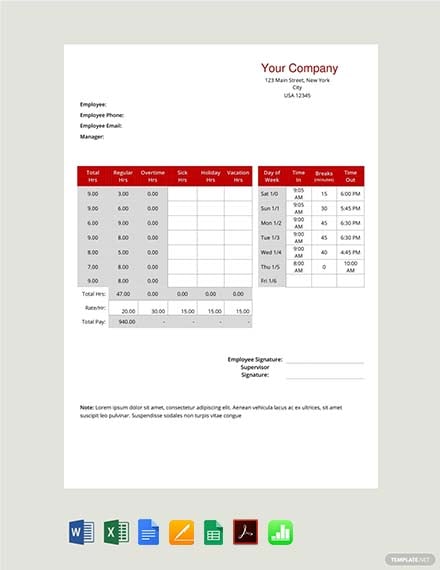

The square brackets tell Excel to exceed 24 hours. In the Type field, type left square bracket, h, right square bracket, colon, and then, mm. To format the cell, right-click it, and click Format Cells. In this example, the total is greater than 24 hours.Įxcel can display time in many different ways, such as hours and minutes, or hours, minutes, and seconds a.m., p.m., or a 24-hour clock or a number that is greater than 24 hours, as is needed in this example. I know the formula is correct, so it must be how cell D4 is configured to display time.
#TIMESHEET TEMPLATE FOR MAC PLUS#
To start a formula, you always use an = sign, click cell D2, type the + sign, click cell D3, and press Enter.ġ2 hours and 45 minutes plus 15 hours and 30 minutes, isn’t 4 hours and 15 minutes.

You could use AutoSum again to add these column’s tasks, or a formula to add these two cells. This is what I want, so I click it again, and get the total time for the tasks. I click it once to see what it is going to add. The best way to do this is to use the AutoSum button on the HOME tab.

Select This Sheet to print only the current sheet, or All Sheets to print every sheet in your spreadsheet.You can add time in Excel just like you add other types of numbers.įor example, you might do this if you want to know how long it took to complete a project’s tasks. Choose Insert > Page Number, Page Count, or Date and Time (from the Insert menu at the top of your screen).Ĭhange the look of header and footer text: Select the text, click Text at the top of the Print Set-up sidebar, then choose formatting options. Insert a page number, page count, or date and time in a header: Move the pointer over a sheet thumbnail in the grid on the left, then click in the header field. You must add headers to each sheet where you want them. To add and edit a header, do any of the following:Īdd text in a header: Move the pointer over a sheet thumbnail in the grid on the left, then click and type in the header field that appears. Page Margins: Enter values or click the arrows next to Top and Bottom to set the page margins. Page Order: Choose whether pages are numbered: top to bottom, then left to right or left to right, then top to bottom. If you don’t want a page number to print on a specific sheet, click the centre of the footer on the sheet thumbnail in the grid on the left, select the page number, then press Delete on the keyboard. If you select “Start at”, type a starting page number. To continue page numbers from the previous sheet, select “Continue from previous sheet”. Page numbers: Page numbers are printed by default. If you turn off sheet backgrounds, all text colours for the sheet are changed to black. Print sheet background: Select the tick box to print sheet backgrounds. Comment flags on the sheet are numbered to correspond with the comments on the comment page. Comments appear on a separate page that follows the sheet. Print comments: Select the tick box to print comments. Repeat table headers: Select the tick box to print table headers on every page where the table appears. (If you open a spreadsheet from Numbers ’09, Fit is turned off by default.) To fit content to the width of a page again, click Fit. To display content across multiple pages, drag the slider to adjust the scale. If you don’t already have a printer set up, open System Preferences, click the back arrow at the top of the System Preferences window, click Printers and Scanners, then follow the instructions.Ĭlick the paper size pop-up menu and choose an option.Ĭontent Scale: By default, Numbers scales your content so that it fits the width of one page. The Print Set-up sidebar opens on the right and your spreadsheet appears in a blue grid on the left.Ĭlick the printer pop-up menu and choose a printer. Open the spreadsheet and choose File > Print.


 0 kommentar(er)
0 kommentar(er)
